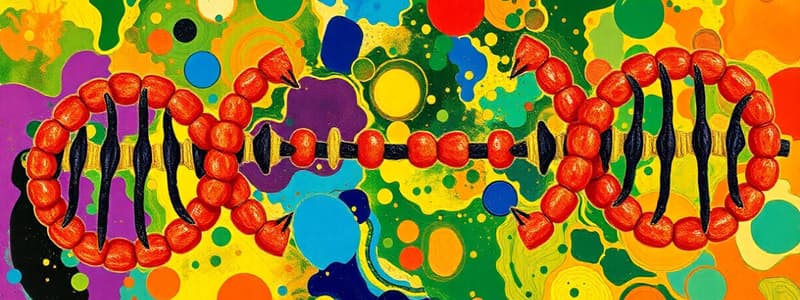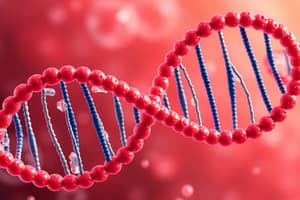Podcast
Questions and Answers
What happens to the parental strands during semi-conservative replication?
What happens to the parental strands during semi-conservative replication?
- The parental strands are randomly distributed in the daughter molecules.
- The parental strands separate, and each serves as a template for a new strand. (correct)
- Both parental strands are completely conserved.
- One parental strand is conserved, and the other is entirely newly synthesized.
During DNA replication, what is the role of helicase?
During DNA replication, what is the role of helicase?
- To synthesize new DNA strands from the existing templates.
- To break the hydrogen bonds between complementary bases and unzip the DNA. (correct)
- To bind to the replication fork to stabilize it.
- To add nucleotides to the growing DNA strand.
What distinguishes the origin of replication in prokaryotes from that in eukaryotes?
What distinguishes the origin of replication in prokaryotes from that in eukaryotes?
- Prokaryotes have multiple origins of replication, while eukaryotes have a single origin.
- Prokaryotes have a single origin of replication, while eukaryotes have multiple origins. (correct)
- Eukaryotes have a unique Ori C, while prokaryotes do not.
- Both prokaryotes and eukaryotes have only one origin of replication.
Which model of DNA replication involves one parental molecule directing the synthesis of a completely new double-stranded molecule?
Which model of DNA replication involves one parental molecule directing the synthesis of a completely new double-stranded molecule?
What is created where the DNA strands are separated during replication?
What is created where the DNA strands are separated during replication?
What role do Single-Strand Binding Proteins (SSBs) play during DNA replication?
What role do Single-Strand Binding Proteins (SSBs) play during DNA replication?
Which enzyme catalyzes the addition of nucleotides to the growing DNA chain in prokaryotes?
Which enzyme catalyzes the addition of nucleotides to the growing DNA chain in prokaryotes?
What is the orientation of the leading strand during DNA replication?
What is the orientation of the leading strand during DNA replication?
Why are multiple primers needed along the lagging strand during replication?
Why are multiple primers needed along the lagging strand during replication?
What is the primary function of the enzyme Topoisomerase during DNA replication?
What is the primary function of the enzyme Topoisomerase during DNA replication?
How does base pairing differ when RNA is involved in DNA replication?
How does base pairing differ when RNA is involved in DNA replication?
What is the consequence of DNA polymerase only being able to add nucleotides to a growing polymer?
What is the consequence of DNA polymerase only being able to add nucleotides to a growing polymer?
Which strand is known as the lagging strand during DNA replication?
Which strand is known as the lagging strand during DNA replication?
During DNA replication, what is the role of primase?
During DNA replication, what is the role of primase?
Flashcards are hidden until you start studying
Study Notes
Replication
- The process by which DNA makes a copy of itself during cell division
- DNA is copied during the "S" or synthesis phase of interphase
- The new cells will require identical DNA strands
Models of Replication
- There are three models of replication:
- Conservative: the parental molecule directs synthesis of an entirely new double-stranded molecule. After one round of replication there is one molecule that is conserved as two old strands
- Semi-Conservative: the two parental strands separate and each makes a copy of itself. After one round of replication, two daughter molecules each comprise one old strand and one new strand
- Dispersive: material in the two parental strands is distributed randomly between two daughter molecules.
Replication Fork
- Daughter DNA is a double helix with 1 parent strand and 1 new strand
- One strand serves as the template for the new strand
- Each strand of the parent DNA is used as a template to make the new daughter strand
- DNA replication makes 2 new complete double helices, each with 1 old and 1 new strand
- The site where replication begins is called "ori"
- In E. coli, there is one called "Ori C"
- In humans, there are thousands called "ori"
- Strands are separated to allow replication machinery to contact the DNA
- Many A-T base pairs are found in the replication origin
- Note anti-parallel chains
- Prokaryotes (bacteria) have a single bubble
- Eukaryotic chromosomes have many bubbles
Unzipping the Double Helix
- DNA helicase separates the two strands of DNA by breaking the hydrogen bonds between complementary bases (A to T, C to G)
- This separation creates a "Y" shape called a replication fork
- The two separated strands will act as templates for making the new strands of DNA
- Single Strand Binding Proteins (SSBs) attach to the DNA and keep the two strands separated and untwisted
- DNA helicase and SSBs lead to DNA unwinding and active replication
- The enzyme Topoisomerase attaches to the two forks of the bubble to relieve stress on the DNA molecule as it separates
Bidirectional Movement of DNA Replication Machinery
- The DNA replication machinery moves bidirectionally
Leading and Lagging Strands
- One strand is oriented in the 3’ to 5’ direction (towards the replication fork), this is the leading strand.
- The other strand is oriented in the 5’ to 3’ direction (away from the replication fork), this is the lagging strand
- The two strands are replicated differently because of their different orientations.
DNA Polymerase
- In prokaryotes, there are three types of polymerase I, II and III
- An enzyme (Pol III) catalyzes the addition of a nucleotide to the growing DNA chain
- A nucleotide enters as a nucleotide tri-PO4
- DNA polymerase can only ADD nucleotides to a growing primer
- Another enzyme, primase, synthesizes a short RNA chain called a primer
- This is a DNA/RNA hybrid for this short stretch
- Base pairing rules are followed (BUT A-U)
Primer Removal
- The primer is later removed and replaced by DNA and the backbone is sealed (ligated)
- In eukaryotic cells, DNA polymerase alpha is responsible for the synthesis of primers.
Leading Strand Replication
- A primer is added along the leading strand
- DNA polymerase reads 3’ to 5’ from the RNA primer
- Synthesis proceeds 5’ to 3’ with respect to the new daughter strand
- The nucleotides are usually added 5’ to 3’
Lagging Strand Replication
- The other daughter strand (lagging strand) is also synthesized 5’ to 3’ because that is the only way that DNA can be assembled; due to this, the opposing template is being read 5’ to 3’
- The DNA strand is fed through the polymerase to compensate for the lagging strand direction
- Many primers are used to make many short segments that are later joined (ligated) together (= Okazaki fragments)
- This is called the lagging strand because it is a discontinuous process (the Okazaki fragments need to be joined up later)
Okazaki Fragments
- Once all of the bases are matched up (A with T, C with G), an enzyme called Exonuclease strips away the primer(s).
- The gaps were then filled by yet more complementary nucleotides.
- Finally, an enzyme called DNA Ligase seals up the sequence of DNA into two continuous double strands.
Studying That Suits You
Use AI to generate personalized quizzes and flashcards to suit your learning preferences.




